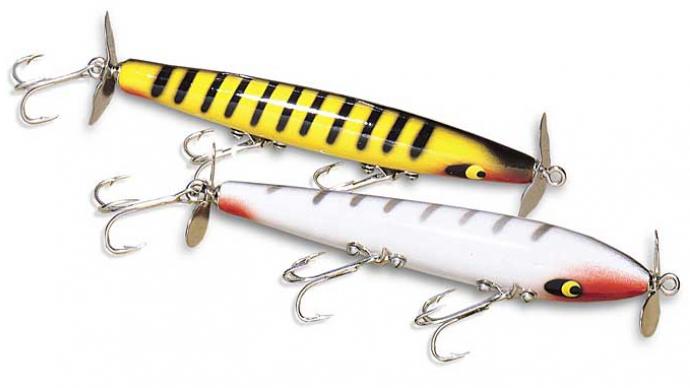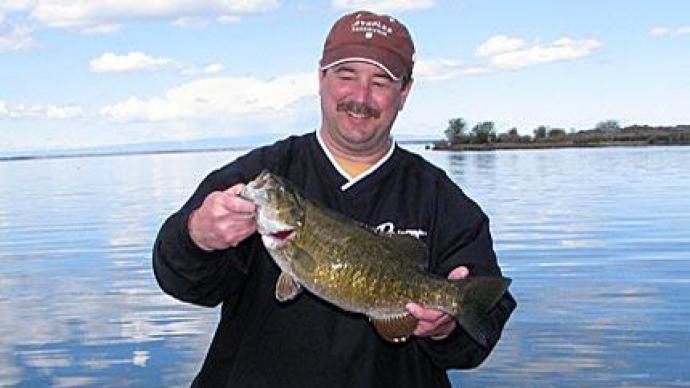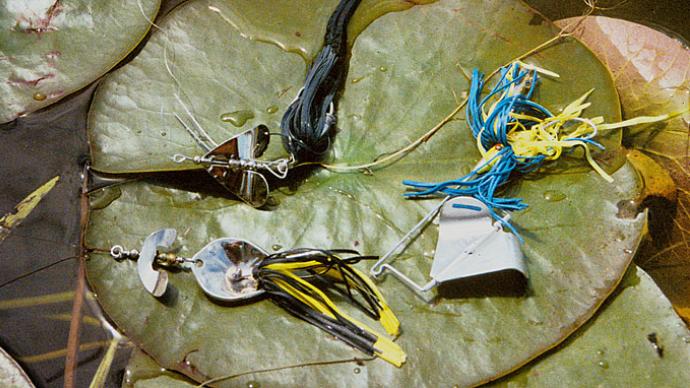
The invention of the propeller changed the world. Whether it was attached to a boat or an airplane, it is associated with high RPM's – (Revolutions Per Minute) – and designed for increasing the speed at which something moves.
So when Smithwick designed and manufactured the Devil’s Horse back in the 1950’s, equipped with not one but two props, it is understandable why anglers still make the connection between props and speed. Novice anglers often tie on the bait for the first time and assume it should be raced across the surface, or “ripped” sporadically back to the boat.
But down in Florida, where the Devil’s Horse has an almost cult-like following, a high speed retrieve is considered by many to be detrimental to consistent success. Among these die-hard propbait fans is Barry Weaver, a successful bass tournament angler, and recently retired painter of custom crankbaits.
If Barry believes the bass are willing to chase down a surface bait moving at high speed, he will reach for a buzzbait. The true secret to fishing a Devil’s horse is to “Go Slow” – to finesse the bait in the right place at the right time.
Woe Horse! Slow Down!
“A lot of people who fish the Devil’s Horse like to rip them and move them fast,” states Barry, “but I will throw it into a spot and let it sit there for 5 to 10 seconds. And if you start to move it right away, a lot of times you will scare the bass away; you can see them run from it.”
Weaver knows this to be true because he has used this technique in clear water, where the bass could be observed. “The bass will come up to investigate, they’ll move underneath it and sit there and watch it. I’ll let it sit the 5-10 seconds and let all the swirls go away. I continue to let it just sit there, and then I’ll give it just a little twitch.”
Twitch It!
That twitch is very subtle, insists Barry, “I don’t want it to move but a couple of inches - just a little twitch. 90% of the time it’s the first two or three twitches that will get the hit.” It’s a painfully slow technique with 5-6 seconds between twitches, and requires the angler to stop thinking about the lure’s propellers and fight the instinctive desire for a high speed retrieve.
Shallow Water, Cover, and Bass
Fishing the Devil’s Horse requires two obvious basics: shallow water and cover. Of course, it first requires bass being in that shallow water cover, but in Florida that is a 12 month blessing that their northern cousins don’t have.
While “Yankee” anglers may have to wait until spring for the bass to move into the shallows before being able to target the cover with propbaits, the Devil’s Horse slow “southern style” technique is effective anytime bass are in shallow cover.
Seasonal or Weather Dependent?
Interestingly enough, southern topwater anglers rarely consider the “seasonal conditions” before throwing topwater, (after all, there are only a few colder months of winter, and the rest is summer), in as much as they pay attention to “weather” conditions. Barry agrees, “I look for the weather rather the season, and I will fish the Devil’s Horse all year long depending on the conditions.”
Even water temperature seems to be disconnected from the propbait’s formula for success down south. “I’ve caught fish on Devil’s Horses in the middle of winter, and in 100 degree summers. So really, I don’t think water temperature bothers the bass down here that much.”
“If you think the bass are going to be up in the shallows, or you see movement and you know they are there, and the weather is favorable, that’s all I’m worried about.”
Ideal Conditions
The ideal conditions for throwing the Devil’s Horse are easy for Barry to describe, “Number one; hopefully it is going to be a windy day. (I’m not talking 30 mile an hour winds, I’m just talking about enough to put some chop on the water.) And I’m going to look for isolated patches of lily pads with the winds blowing up to it, and I am going to fish the windy side of those pads.”
A Little Wind
“The fish love to get on the windy side of any kind of cover, whether it’s shoreline, an isolated mud bank, or anything that has wind and current going to it. The bass will sit there on the edge and ambush anything that comes their way. If the wind is blowing shad up under the pads or into the grass, the bass are going to sit right there, making it a prime target for the Devil’s Horse.”
That doesn’t mean Barry won’t throw the propbait on a windless day. “If I have a calm day, and I am able to ‘look for sign’, that is, if I see little pads moving up close to the shore, that’s a prime topwater location. I’m always watching the shoreline and watching the grass. A fish is not going to sneak through Kissimmee Grass and not move it, so I am always watching. If I see movement, I throw the Devil’s Horse close to it.”
Weeds, Pads, Grass!
The vast majority of the cover that Barry targets is aquatic vegetation, especially lily pads. “If I am doing topwater, I’m tossing at green vegetation. Or we have something we call Kissimmee Grass which is like a little pepper grass that is real thick, and it will die off in the cold months but remain there.”
Though there are stump fields in many of the lakes that Barry competes on, “I’m probably not going to throw a topwater into stump fields very much.” There are other baits better suited for the woody environment.
And the same is true of open water situations. Should Barry come across schooling fish, (chasing shad balls in open water), he’s likely to throw other baits - unless the Devil’s Horse is the only bait he happens to have tied on. He usually reserves the Devil’s Horse for shoreline cover that consists primarily of aquatic vegetation.
An Easy Meal!
The Devil's Horse is excellent at appealing to the bass' craving for an easy meal. “You have all kinds of fish up in the shallows attacking and eating shad and minnows, so there’s always injured shad jumping around. So I would imagine that’s what they think the Devil’s Horse is – an easy meal.”
Water Clarity?
A common misconception from out-of-state anglers is that Florida’s lakes and rivers are all clear water environments, and that the Devil’s Horse is a clear water lure. Barry says that is not true. “We actually have a lot of muddy water down here. Actually only one percent of the water I fish has super clear water.”
“Most of the places I fish actually have dirty water. Lake Rousseau, Rodman Reservoir… occasionally you can find clear water. But on a scale of 1-10, they’re a 7 in terms of dirty water. I wouldn’t say its black water, but it’s real tannic.”
In dark water situations Barry tends to use either noisy crankbaits, (like the lipless Rat-L-Trap), or topwater baits that the bass can hear and hone in on. “With the Devil’s Horse you’ve got the splashing and popping from the spinners, and the bass can get tuned in on that kind of thing in dirty water.” Therefore, in most situations, water clarity is irrelevant, and not a negative factor affecting the propbait’s success.
Depth?
Neither is depth a major factor. “I’m not zooming in on the water depth. I’m more looking at the surface cover, because sometimes I’m fishing in a foot of water, and other times that shoreline may be 10 feet deep and I’m fishing next to that cover. Mainly it’s the cover I’m concerned with – more so than the depth.”
Good – A Miserable day!
If Barry could fine tune the weather, it might surprise some anglers as to his choice, “Definitely overcast, a little bit of chop, 5 to 10 mph wind, and personally I prefer rain – a light drizzle. That’s perfect! Some of my best days are the days when most guys stay home; a little rain, a little wind, overcast – just a miserable day but the fishing just seems to be ‘killer’.”
What weather conditions would Barry desire the least, when fishing the Devil’s Horse? “Blue-bird skies. I would even mess with it.” On those days Barry would most likely be flipping or throwing plastics.
Thrown In Conjunction With Crankbaits
But when conditions look good, Weaver is going to throw the topwater in conjunction with other crankbaits. “I’m big time into crankbaits now,” admits Barry, “I throw a Rat-L-Trap 50% of the time. I like moving and covering water.”
“We’ve got guys here in Florida that will flip a 100 yard bank all day, and I don’t know how they do it. I like to change up and keep running. I keep moving, using crankbaits as a search tool. And after I find the fish, that’s when I slow down and begin to throw the Devil’s Horse.”
The PROP’r Rod
When our Florida expert takes a beginner out on the lake to teach them how to catch bass on a Devil’s Horse he begins by handing them a 7 to 7 ½ foot graphite baitcasting rod. “I’m using all Deep South rods now, and for throwing propbaits I like a stiff rod. Why? Because when you twitch it with a stiff rod, you can make that bait do whatever you want it to do.”
A flimsy noodle rod is to be avoided because “You don’t want any recoil from the rod making an extra twitch in there. If you just want to bang it one time to get the lure to go around that lily pad – that stiffer rod is perfect for it.”
Barry will not go so far as suggesting a heavy action rod. “Maybe a medium heavy action,” he says, “and something long enough so that when you are trying to get the bait to go around some kind of cover, you can move the rod and accomplish the task.”
Not REEL Important
In terms of the proper reel, Barry tends to lean toward the “use what you got” camp when it comes to the propbait. “Because I fish the Devil’s Horse so slow, a 3:5, 5:1 or 7:1 gear ratio works – whatever you want to use will be fine.”
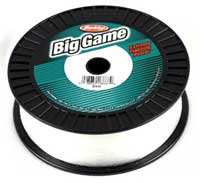
His reasoning for this is simple: the distance that the propbait is twitched near the edge of the cover is usually only 5 or 6 feet, (before it is quickly retrieved and recast), and the working or action of the bait is primarily a product of rod tip movement, not reel speed and line intake. In short, an angler doesn’t have to get any special equipment to throw and work a Devil’s Horse correctly.
A Simple LINE
Barry’s ‘keep it simple’ approach to equipment also applies to line selection. “I stick with monofilament; 12-14 poundBig Gameis what I use for most of my topwater.” He sees no advantage to using the expensive braids or fluorocarbons.
He adds, “There’s no reason to use thinner lines, (no need to go down to 6 pound test), when throwing a Devil’s Horse. And there is no reason to go up in line size unless you are going to go fishing for sharks or something. 12-14 pound mono works great.”
The Devil’s Horse
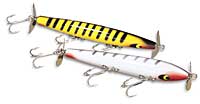
TheDevil’s Horse is a wooden bait whose round profile is turned on production lathes. It is roughly 4.5 inches long, (11.4 centimeters), and comes in two weights – the 3/8 ounce and the 1/2 ounce versions.
Old timers can remember when it came in larger versions, (often used by Pike fishermen), but in recent years Smithwick’s website only offers it in the 3/8 and 1/2 sizes.
Which size does Barry use? “I have used the 1/2 ounce model maybe twice in my life.” Is this due to some strong opinion based on decades of experience? No. Barry admits it is “Mainly because they don’t sell them down here – you can’t find a ½ ounce DEVIL’S HORSE anywhere locally.” He believes they are available on line, but he has had such phenomenal success on the 3/8 ounce model, that there has been no motivating reason to use anything else.
In This Corner: Boy Howdy

Smithwick’s long time competition is Cotton Cordell’s “Boy Howdy”– similar in profile but now made of plastic. It tends to sit tail down in the water, while the wooden Devil’s Horse lies flat on the water. Debates as to which propbait throws the most water has been going on for decades with each camp convinced their favorite has the advantage.
But Barry does not take part in such discussions because “If I want a bigger splash than I get with a Devil’s Horse, I will go to a popper. Even if another propbait does make a little more splash - I don’t really think it is that necessary.”
“Usually, when I’m fishing it as slow as I do, I don’t get a lot of splash from the props anyway. Remember, I’m just moving that propbait like wounded forage or a little bait fish looking for food on top; real slow – twitch, twitch, twitch, so I am not moving it a lot.”
A Curious Color Combo

As a custom crankbait painter, one might think that Barry Weaver would have a deep and profound philosophy concerning the color of his favorite and most productive Devil’s Horse. But he is quick to confess that there is an element of mystery in why his favorite pattern is so successful. “I have every color in my box, but there is one color that is the biggest catcher.” And the reasons for that color combination’s success is hard to pin down.
Why? Because most of the time, baits that “match the hatch” tend to bring in the greatest stringers. Imitating the local forage is a tried and true formula. His Rat-L-Trap painted in a Golden Shiner pattern is a great example. The reason, Barry explains, lies in the fact that “Golden Shiners are the number one forage fish here. Next… we would go with little silver side minnows.”
So does Barry’s favorite Devil’s Horse color reflect the primary local forage? “I go with silver chrome sides, orange belly, and blue back.” And Barry confesses, “I don’t know what that imitates. You’ve got the shiner in the middle, but bluegill on the bottom. And as to the blue back… well, I’m not sure, because we don’t have any freshwater forage with blue backs.”
Mystified!
As a lure painter, he has experimented with dozens of color combinations and all have failed to match the productivity of his favorite. “I’ve even tried frog patterns, fished in placed where I have caught fish on soft plastic frogs and… no good. But I can go back in there with that chrome side, orange belly, and blue back Devil’s Horse… and get hit. I’m telling you, I really don’t know what that color combo is supposed to imitate.”
Another thing that mystifies Barry is that he prefers to throw it on overcast days. “What’s weird, is that it is a chrome-sided bait. And usually chrome baits work best when the sun is out – you can really see the reflection off of the chrome. But for some reason, the lack of sunlight really doesn’t seem to matter. That strange color combination is the one they want 90% of the time, even on overcast days.”
The only possibility that makes sense to Barry - he offers cautiously, “It might be the orange belly. A lot of my crankbaits have the orange belly and I think that is the key down here in Florida because our bass eat sunfish and other panfish like there is no tomorrow. And most of the panfish have that yellow belly. So maybe they just get a glimpse of orange and jump on it – possibly it’s a reaction instinct.”
The TOP of the Topwater Bait!
Which leads us to a highly debated question: Can fish see the top of a floating topwater bait? Some say yes, and explain that it has to do with the light refraction characteristics of the surface water. Others say no, and that fancy finishes produced on the top of floating topwater baits exist only to entice buyers, not fish.
While Barry doesn’t have a scientific explanation for his opinion, he has one. “Personally I think they are only seeing the belly. If you have a topwater that sits nose or tail down in the water, I would imagine every time you pop it, the bait is going to do a little nose dive and the fish might get a glimpse of the edge or even the top of the bait. But with the Devil’s Horse, I think they see just a little bit of the bottom and the sides.”
“I’ve had other anglers joke with me about this, and say ‘Hey why don’t you just paint me a white bait with an orange scale belly and we’ll see what it does?’” Barry is tempted to do just that, predicting with confidence that it would prove to very successful.
In PART II - Barry Weaver discusses propbait modifications, and then explains where and how to fish the famous Devil's Horse. The proper rod angle, and hookset are explained, as well as the best way to fight the bass back to the boat. Boat control and other tips are shared to increase an angler's success in using the Devil's Horse propbait.
---------------------------------------------------------------------------------------------------------------------
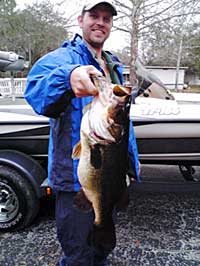
Barry Weaver has been a successful Florida bass tournament angler and was the owner of "The Crankin' Cracker" - a custom painted crankbait shop. He is now retired from the fishing industry, and residing in Silver Springs, Florida.


